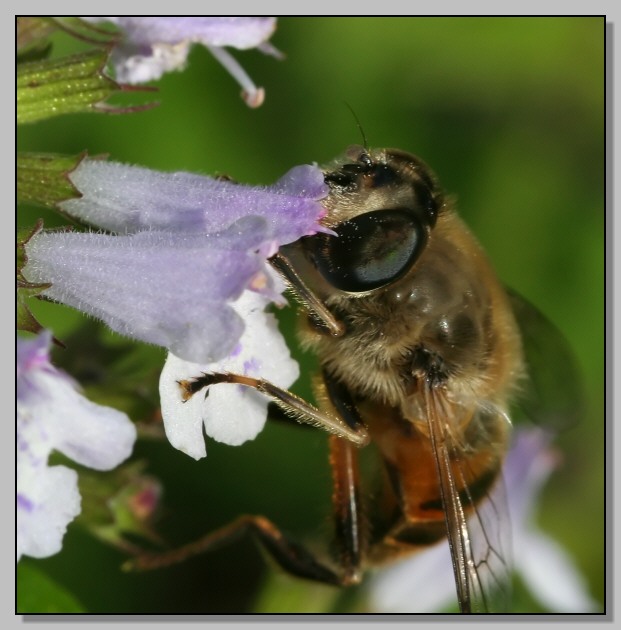Thread subject: Diptera.info :: Let's see if I'm learning, Eristalis tenax?
Posted by lynkos on 05-11-2005 07:32
#1
When I came across this Eristalis the other day, the first thing I did (and the only thing as afterwards he disappeared) was to photograph the eyes. If I've understood the explanation of Andre right, that black tuft on the "forehead" should make him Eristalis tenax. How am I doing?

Thanks in advance, Sarah
Posted by Kahis on 05-11-2005 14:37
#2
Hi again!
He is a E. tenax for sure. 'He' is also a female.;) I'm not quite sure what black tuft you are tal?king about. The characteristic vertical hair stripes are not very well visible in this pic. Take a look at
http://www.lesins..._tenax.htm
The 2nd pic (from ventral side) shows the hair pattern quite well, and it is also visible in the head shot as two darker lines crossing the eye.
Cheers,
Kahis
Posted by lynkos on 05-11-2005 21:17
#3
Yes, what you rightly call a stripe is what I called a tuft! It is not that visible in this photo, but there were others which I discarded where it could be seen quite clearly. Next question, how do you know he's a she?! Sarah
Posted by Andre on 06-11-2005 16:17
#4
Like kahis correctly says, it's not the hairs on the fore-head that is used to determine this species. It's the two "thicker" rows of vertically growing hair-bandes on the eyes (in fact, it is where the hairs on the eyes grow more dense than elwewhere on the surface of the eyes).
One of these rows (or bands if you like) shows clearly on this picture.
What we also check is the color of the tarsae of the forelegs. In this picture not visible. If the tarsae are all yellow, we know directly we are dealing with the species Eristalis pertinax. Comes quite handy when other feateres don't show well... Anyway.... this was a sidestep.
How we see if it is a male or a female: in Eristalis the eyes of the males reach eachother, while the females are dichoptic which means the eyes are clearly seperated by a broad part of the forehead (the frons).
Because of the fact that in males the eyes meet on the forehead (above antennae) there is only a small, triangular space left on the head just above the eyes.
There are quite some diptera-families where same features appear as a matter of fact. Just be aware of the exceptions though, 'cause there always are exceptions.... that's nature! ;)
Posted by lynkos on 06-11-2005 18:34
#5
:o what a lot there is to learn! Thanks so much, I'll know what to look out for next time, Sarah
Posted by Andre on 07-11-2005 00:46
#6
In humans, the eyes are clearly dichoptic in both sexes! :)
Usually, ofcourse! :D
Posted by lynkos on 07-11-2005 08:40
#7
Andre wrote:
In humans, the eyes are clearly dichoptic in both sexes! :)
Usually, ofcourse! :D
:o B) Sarah
Posted by Kahis on 07-11-2005 15:22
#8
lynkos wrote:
:o B) Sarah
Good example!
:o: Eyes don't touch -> female
B): Eyes touch -> male
:pB) Kahis
Edited by Kahis on 08-11-2005 16:05
Posted by Andre on 07-11-2005 16:36
#9
That's not fair Kahis! What happens when a woman carries sunglasses? She turns into male? :D
Posted by lynkos on 08-11-2005 07:55
#10
This is a lesson I'm never going to forget, thanks guys for making me smile! Sarah
